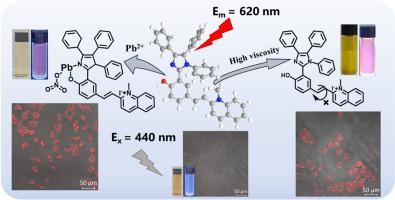基于喹啉-咪唑的亲水性“开启”荧光探针特异性检测Pb2+和粘度
IF 4.2
3区 工程技术
Q2 CHEMISTRY, APPLIED
引用次数: 0
摘要
本文研制了一种新型的双响应荧光化学传感器(HPI-Qu),该传感器基于喹啉和咪唑基团,具有聚集诱导发射增强(AIEE)特性和良好的水溶性,用于检测Pb2+和粘度。该探针结合Pb2+后在620 nm处表现出明显的“开启”荧光响应,具有响应时间快(20 s)、选择性高、对Pb2+具有良好的抗干扰能力等优点,结合常数Ka为0.75 × 106 M−1。Pb2+的最低检出限为0.08 μM,远低于世界卫生组织(WHO)规定的饮用水中Pb2+的最大允许值。通过Job’s plot、FTIR光谱、1H NMR滴定实验、ESI-HRMS谱法和理论计算确定探针HPI-Qu对Pb2+的结合机理。此外,HPI-Qu在1.01-1412 cP范围内表现出明显的开启黏度依赖性,与黏度呈良好的线性关系。此外,HPI-Qu探针具有良好的细胞渗透性和生物相容性,可用于检测活细胞中的Pb2+和黏度。这表明探针HPI-Qu在环境和生物系统中监测Pb2+和粘度具有潜在的应用前景。本文章由计算机程序翻译,如有差异,请以英文原文为准。

Quinoline-imidazole based hydrophilic “turn-on” fluorescent probe for specific detection of Pb2+ and viscosity
Herein, a novel dual-response fluorescent chemosensor (HPI-Qu) based on quinoline and imidazole moieties with aggregation-induced emission enhancement (AIEE) properties and good water-solubility was developed for the detection of Pb2+ and viscosity. The probe exhibits a remarkable “turn-on” fluorescence response at 620 nm upon binding Pb2+ in aqueous media and has the advantages of fast response time (<20 s), high selectivity and excellent anti-interference ability for Pb2+, and the binding constant (Ka) was 0.75 × 106 M−1. The low detection limit for Pb2+ was found to be 0.08 μM, which is far below the maximum allowable value of Pb2+ in drinking water fixed by the World Health Organization (WHO). The binding mechanism of the probe HPI-Qu toward Pb2+ was determined by Job's plot, FTIR Spectral, 1H NMR titration experiments, ESI-HRMS spectrometry, and theoretical calculation. Additionally, HPI-Qu displays significant turn-on viscosity-dependent behavior and a perfect linear relationship with viscosity in the range of 1.01–1412 cP. Furthermore, the probe HPI-Qu exhibits good cell permeability and biocompatibility, and could be applied for detecting Pb2+ and viscosity in the living cells. This indicates that the probe HPI-Qu has potential application prospects for monitoring Pb2+ and viscosity in environmental and biological systems.
求助全文
通过发布文献求助,成功后即可免费获取论文全文。
去求助
来源期刊

Dyes and Pigments
工程技术-材料科学:纺织
CiteScore
8.20
自引率
13.30%
发文量
933
审稿时长
33 days
期刊介绍:
Dyes and Pigments covers the scientific and technical aspects of the chemistry and physics of dyes, pigments and their intermediates. Emphasis is placed on the properties of the colouring matters themselves rather than on their applications or the system in which they may be applied.
Thus the journal accepts research and review papers on the synthesis of dyes, pigments and intermediates, their physical or chemical properties, e.g. spectroscopic, surface, solution or solid state characteristics, the physical aspects of their preparation, e.g. precipitation, nucleation and growth, crystal formation, liquid crystalline characteristics, their photochemical, ecological or biological properties and the relationship between colour and chemical constitution. However, papers are considered which deal with the more fundamental aspects of colourant application and of the interactions of colourants with substrates or media.
The journal will interest a wide variety of workers in a range of disciplines whose work involves dyes, pigments and their intermediates, and provides a platform for investigators with common interests but diverse fields of activity such as cosmetics, reprographics, dye and pigment synthesis, medical research, polymers, etc.
 求助内容:
求助内容: 应助结果提醒方式:
应助结果提醒方式:


